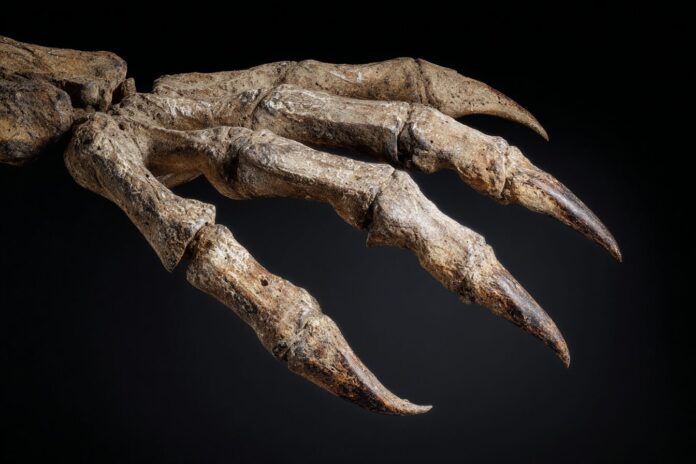Meet Shri rapax: A Lethal Addition to the Dromaeosaurid Family
Most importantly, the recent discovery of Shri rapax has captivated paleontologists worldwide, as it reveals a startling evolutionary deviation among dromaeosaurids. Because this predator did not conform to the typical Velociraptor anatomy, its existence has broadened our understanding of dinosaur predation.
In addition, researchers found that the oversized, razor-sharp thumb claw of Shri rapax distinguishes it from related species. Therefore, this discovery underscores the adaptive nature of dinosaur evolution and prompts scientists to reevaluate long-held assumptions about raptor behavior. The unveiling of Shri rapax has sparked renewed interest in studies focusing on anatomical innovation, as detailed in related analyses at ScienceAlert.
Why Shri rapax Stands Out Among Raptors
Besides possessing giant thumb claws, Shri rapax exhibits notable morphological differences that set it apart from its well-known relatives like Velociraptor and Deinonychus. Because these raptors typically leveraged their sickle-shaped toes, the evolution of such a distinctive hand weaponry in Shri rapax represents a major adaptive shift.
Moreover, the variation in its anatomy allows us to consider a broader spectrum of predatory strategies. Most notably, the use of a hand-based attack mechanism could explain new hypotheses about prey capture and environmental adaptation. Consequently, paleontologists are now encouraged to explore both manual and pedal adaptations in dromaeosaurids to understand their unique hunting mechanisms, as further described in a recent article from OrthoTraining Consult.
Evolutionary Advantages: Thumb Claw Warfare
Because of its massive thumb claw, Shri rapax likely employed a predatory technique that differed from the foot-based strategies seen in other raptors. Most importantly, this adaptation could have enabled it to inflict deep and debilitating wounds on its prey through slashing motions executed with its forelimbs.
Besides attacking larger or tougher prey, this innovative weapon system may have allowed Shri rapax to perform a variety of actions such as defensive maneuvers and even climbing when necessary. Therefore, studies suggest that this thumb adaptation not only increased its offense but might have also broadened its survival tactics in complex environments, as outlined in discussions on Smithsonian Magazine.
Dromaeosauridae: Diversity and Specialization
The Dromaeosauridae family is renowned for its diversity and specialization among predatory dinosaurs. Most notably, this grouping ranges from the lithe Velociraptor to the more robust Deinonychus. Because each species evolved specific features, the emergence of Shri rapax with its giant thumb claws signifies yet another evolutionary experiment within this family.
In addition, comparative studies indicate that regional differences influenced morphological traits. For instance, while Laurasian dromaeosaurids developed short and powerful foot digits for quick, lethal strikes, some Gondwanan species like Shri rapax evolved longer and more flexible digits. Therefore, analyzing these differences provides invaluable insights into how environmental pressures shaped predatory techniques over millions of years. More detailed discussions of the dromaeosaurid family can be found on Wikipedia.
How Did Thumb Claws Affect Predatory Behavior?
Most importantly, the unique hand adaptation in Shri rapax opens up exciting possibilities regarding its predatory behavior. Because it did not rely on the typical hind-foot attack mechanism, it likely executed dynamic slashing or grappling maneuvers with its forelimbs, allowing for more versatile engagement with prey.
Besides that, the strategic use of its thumb claw may have led to entirely new hunting techniques. Therefore, this adaptation not only provided a physical advantage in combat but also likely influenced its overall behavioral ecology, allowing it to hunt larger or more evasive prey. Emerging theories in paleontological research support these views and underscore the evolutionary significance of such morphology changes.
Unveiling Shri rapax: The Science Behind the Discovery
The discovery of Shri rapax was primarily driven by exceptional fossil preservation, which offered unprecedented clues about its hand morphology. Because the fossilized remains showcased a prominent, curved thumb claw resembling a built-in scythe, researchers were able to affirm that this was not an isolated anomaly but a recurring adaptation seen in some dromaeosaurid branches.
Moreover, detailed comparative analysis with other theropods revealed that such adaptations were likely instrumental in expanding the predatory repertoire of these dinosaurs. Consequently, this breakthrough has prompted further investigations into the functional biomechanics of raptor limbs, as discussed by experts at ScienceAlert.
Velociraptor vs. Shri rapax: Raptor Cousins Compared
Comparing predators within the dromaeosaurid family highlights the incredible evolutionary ingenuity of these creatures. Most notably, while the Velociraptor relied on its foot’s sickle claw to pounce and slash at prey, Shri rapax exhibits an advanced attack strategy with its formidable thumb claws.
In addition, the following table contrasts the specialties of these two raptor cousins, emphasizing how ecological niches and evolutionary pressures drove different adaptations and hunting techniques:
| Dinosaur | Main Predator Weapon | Typical Prey | Distinctive Behavior |
|---|---|---|---|
| Velociraptor | Foot sickle claw | Small to medium animals | Pounced and slashed with hind feet |
| Shri rapax | Thumb razor claw | Possibly larger, tougher prey | Slashed and grappled with hands |
Implications for Paleontology and Dinosaur Evolution
Because our understanding of dinosaur predation continues to evolve, discoveries like Shri rapax significantly impact the narrative of paleontological research. Most importantly, they challenge conventional wisdom and spark debates over the diversity of hunting strategies among ancient predators.
Besides that, new findings encourage scientists to incorporate hand morphology into evolutionary studies, rather than focusing solely on well-known attributes such as foot claws. Therefore, these revelations promote a more nuanced interpretation of the factors that drove the evolution of predatory dinosaurs, emphasizing the role of environmental pressures and competition in shaping their anatomy. For further reading on adaptive strategies in dinosaur evolution, refer to detailed articles on Smithsonian Magazine.
The Legacy of Lethal Raptors
Most readers have long associated raptors with the iconic image of a swift, foot-claw attacker. However, the emergence of Shri rapax and its extraordinary thumb claws enrich our understanding of the predatory toolkit available to these dinosaurs. Because of its unique mix of features, this raptor showcases the evolutionary plasticity inherent in the dromaeosaurid lineage.
In addition, the study of such adaptations not only deepens our insight into the Mesozoic era but also underlines the complexity of interactions within prehistoric ecosystems. Therefore, continued paleontological research is likely to uncover further surprises that may rewrite chapters of scientific textbooks. For those intrigued by these revelations, additional insights are available at both ScienceAlert and related scholarly resources.
References and Further Reading
To learn more about these fascinating discoveries and the broader implications for dinosaur evolution, consider exploring the following resources:
- ScienceAlert: This Deadly Velociraptor Cousin Brandished Giant Razors For Its Thumbs
- Wikipedia: Dromaeosauridae
- OrthoTraining Consult: Detailed Analysis of Predatory Adaptations
- Smithsonian Magazine: Encountering the Frightening Cousin of Velociraptor



